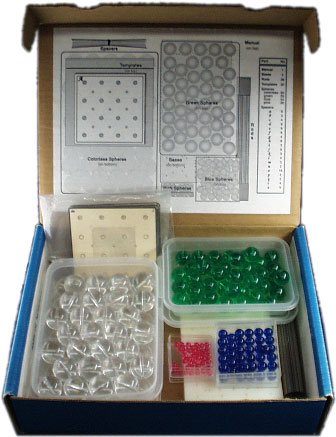Solid-State Model Kit
The Solid State Model Kit allows you to build three dimensional
models of many common and interesting crystal structures including ionic
solids, metals and semiconductors. These models may be examined from many
angles to show how atoms or ions are arranged in the crystal lattice.
An instruction manual with directions for building over eighty different
structures is provided.
Despite their prevalence, extended structures are notoriously difficult
to visualize, a problem that has historically limited their inclusion
in many introductory science and engineering courses. Two dimensional
pictures are at a dimensional disadvantage in capturing the essence of
these structures, and software packages lack the tactile component that
so directly reveals the spatial relationship of atoms to one another.
The objective of the ICE Solid-State Model Kit is to demystify these structures—to
make them comprehensible by enabling the user to construct the structures
in a layer-by-layer manner that illustrates their structural symmetry.
Many of the structures can be built from two complementary geometric perspectives—sitting
on the face of a cube and on its body diagonal, for example. And natural
cleavage planes possessed by many of the solids are easily located by
lifting one sphere and watching others be carried along.

The kit includes two bases, metal rods, templates,an assortment of radius-ratio
sized spheres, and a 126 page instruction manual.
To order a kit contact the Institute
for Chemical Education.
Unfortunately the Institute for Chemical Education at the University of Wisconsin Madison shut down during COVID and has not reopened.
This kit was created by Ludwig A. Mayer (San Jose State University) and George C. Lisensky (Beloit College) who coauthored the instruction manual along with Jill C. Covert (Beloit College)

